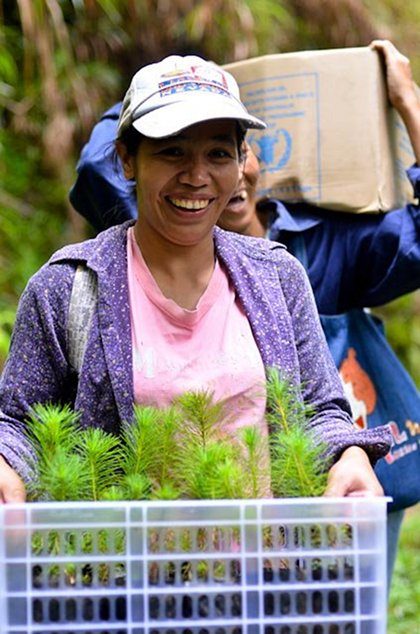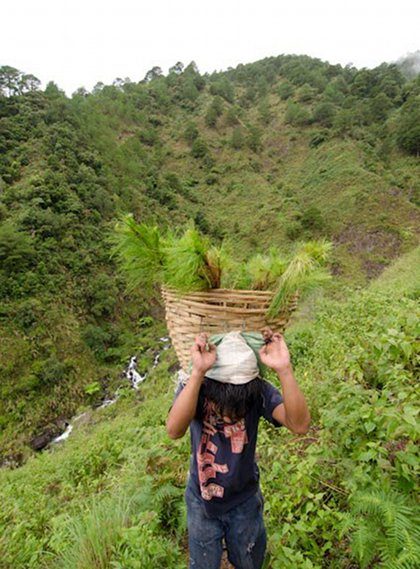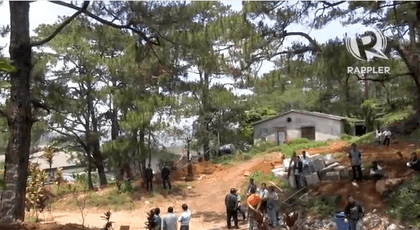SUMMARY
This is AI generated summarization, which may have errors. For context, always refer to the full article.

MANILA, Philippines – We don’t plant trees, we build forests. This has been our organization’s commitment since that first day we stood on a barren mountaintop with 25 individuals digging holes on ground that once was a forest, seeking to rebuild the structures that took centuries to grow but only hours to destroy.
Last year we planted at least 40,000 trees in different parts of the mountains, but that is not the point. The point is there are no more forests.
Forests are some of the hardest structures to build. Each year we have to contend with climate change, typhoons, fire, drought, rain, landslides, wind, cows, disease, and people. If we are lucky, like we were last year, 90% survive till the next year. But quite often there is so much uncertainty that the original architectural vision is whittled down from skyscraper dreams to a small grass roof shack on the mountaintop.
Yes forest building is hard, planting trees is the easy part.
Forests are the epitome of self sacrifice. They produce much for the environment while taking very little from it, with a little light and water they produce life, literally. Forests are not just trees. Much of what a forest is, is far from the trees that grow within it.
A forest is a symphony of life – from the bacteria in the soil to the birds that live on the rooftops and small animals that crawl, hop, and flit through the canopy and across the ground the litter. The forest is more alive than most ecosystems, save the coral reefs of the sea.

Building forests
It takes decades for a group of trees to become a forest, to be able to house all the organisms that live within it and be able to provide a home. The most ambitious builders don’t have it this hard or have to deal with so much of the engineering problems that have to do with building a forest. Much of what is involved in building is, in fact, left to chance or more aptly Mother Nature.
A single tree in the wild produces millions of seeds of which it expects only a small fraction to grow to maturity. Yet these structures, once fully erected, provide water for hundreds of thousands, clean air, prevent erosion, and create a safe living space for millions of organisms.
Through the years we have improved on our methods and increased our chances of building mega structures (forests). We’ve institutionalized forest-nurturing activities to care for the growing foundations.

Since last year we have started building nurseries through our roots and shoots program with elementary schools in remote regions of our mountains to better promote the idea of conservation among the youth and their parents, and provide raw materials for our forest-building activities locally.
Still with all these efforts we have found that protecting already existing forest areas is still easier than rebuilding a demolished forest. They provide not only ecosystem services for the organisms and communities around, but also sources of biodiversity for our roots and shoots nurseries to provide the best construction materials for forest building. Plus they have the added benefit of being able to naturally retake the land and construct their own megastructure as long as human intervention is minimized.

Missing the forest
Yes, planting trees is important but only in logged over and barren areas. To cut down a forest to plant more trees defies logic. But for the forests that still exist today we must protect them because they are so few and far between – pretty soon like the dinosaurs you will only see the forests in books but no longer in the wild.
You may see trees, yes, you may see a million trees in pots, in the malls, on top of parking structures and green roofs, but they will no longer be a forest. Baguio is a city that is lucky enough to have a forest right at its heart, a symbol much like the cathedral you can see from any point in the city.
This forest in the heart of Baguio is the best example of a megastructure in this country that is built by both humans, and the environment is a success story in itself and a symbol that change is possible for our ecosystems.

Protecting it is not simply about protecting a small patch of green, but akin to protecting the Empire State building or closer to home, the World Heritage Rice Terraces found just next door, built by man in partnership with nature.
Today with the advent of social media and global exchange of information, this forest can be seen not only in Baguio but all over the country and even the world. It is a symbol of sustainability and our society’s ability to change the way we develop our land. What happens to it sets the precedent for how we decide development in the future.
We believe that there is hope for our forests, and we see that happening every time we go out into the mountains to build a new one. But for all that work of building forests to make a difference, we must protect the forests that remain, and the symbols that stand for these forests – like the green megastructure that stands in the center of Baguio City.
Leave the trees where they lay, and let the forest be. – Rappler.com
Add a comment
How does this make you feel?
There are no comments yet. Add your comment to start the conversation.